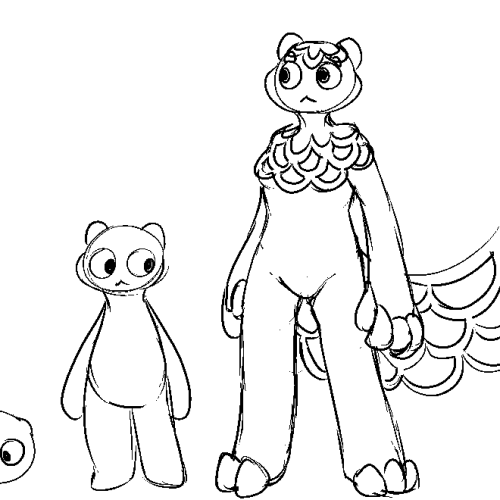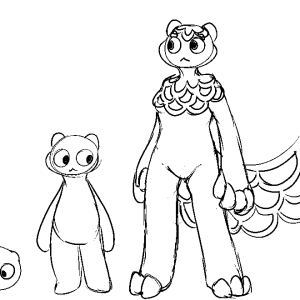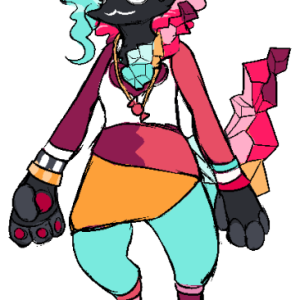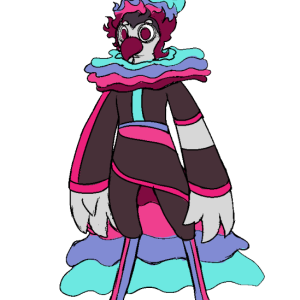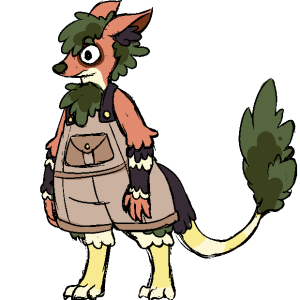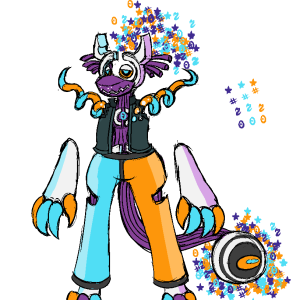Concepts
Table of Contents
Concepts are an extremely variable species that feature prominent motifs that manifest in a metamorphosis process which is a part of their puberty. They can resemble any type of creature and can sometimes lose the resemblance after their metamorphosis.
Origin
Concepts originate in a currently unknown zone where they were created by an unknown god. They lack any true morphs due to the wide variance of shapes and forms they can take.
Appearance
Concepts vary in shape intensely for post-metamorphosis, but pre-metamorphosis concepts tend to be round and squishy looking, only attaining limbs and a bipedal body plan gradually over the course of their childhood.
Most concepts do not have much in the way of complex markings unless their motif or variant calls for it, many only possess plain markings. There are always exceptions to this.
Concept voices vary based on their motif post-metamorphosis but typically sound like distorted speech pre-metamorphosis.
Concepts of variants that would logically have paw pads typically possess them.
All concepts have some form of tail post-metamorphosis, composed of their motif. The majority of concepts are tailless pre-metamorphosis, and this feature develops during their transformation.
Most concepts have some hair post-metamorphosis, which is typically made out of their motif but sometimes not. Lacking hair or head-motif ornamentation post-metamorphosis is very rare and is considered undesirable, sometimes earning the concept in question mockery. Similar to tails, these are typically not present pre-metamorphosis.
Concepts range from 4’6-6’6 at a “normal” adult height, but this varies wildly due to variants.
Their limbs vary wildly from concept to concept based on their variant, possessing anything from paws to wings to hooves. Both digitigrade and plantigrade legs have been noted, though all concepts are bipedal.
Biology
Concepts usually lack skeletons, muscles, nerves, organs, or blood. These structures even when present are not typically functional and function as all other motifs do.
Concepts have one of their internal motifs made external after a process called their “metamorphosis”, see life cycle section, which then becomes prominent on their bodies. This motif presents around their neck and chest areas, and in place of their hair and tail.
Internal motifs are determined through the course of one’s life and typically correspond to one’s sense of self and identity, as well as imagery that resonates with them as a person, whether they like it or not. These motifs are typically fluid through a person’s life until locked into godhood through ascension. The creator of concepts used the same mechanic to make said motifs manifest on the bodies of their species. Due to metamorphosis typically taking place during puberty for concepts, once it begins, the most powerful or prominent motif for the concept in question is locked in and begins to manifest externally, the development is indicative of the stage of their pubic development.
The motif components located around their neck and chest are often referred to as a “core”, not unlike the elementals the species were inspired by. Unlike elementals, however, these features have no purpose in reproduction and mainly serve as a visual indicator of their motif.
Their bodies are completely solid up until metamorphosis, aside from their mouth and a small internal cavity, located around the upper chest, for food to dissolve in. This cavity does not contain any liquid, and food dissolves as if by magic very shortly after entering.
A concept’s body can also change with the “complexity” of their metamorphosis, with low-level complexity concepts finding their bodies relatively simplistic and the only changes being in internal material, such as a candy motif concept having “default” silicone-like skin and a gelatin-like internal material. Medium-level complexity concept having changes seep into their external appearance as well, taffy-like skin as well as the internal structure. High-level complexity, where the entire concept’s appearance has been overtaken by the motif, the entire concept is edible, easily susceptible to temperature changes, and requires accommodations to remain stable.
Some high complexity concepts have had their body parts split or segment into floating pieces during metamorphosis, an incredibly painful process that can sometimes be traumatic in and of itself.
Concepts have some degree of magical ability, though this tends to manifest through subconscious, and uncontrollable, ways related to their motifs, and in reaction to their emotions. For instance, a fire motif concept may burn brighter when upset or excited, and an apple motif concept’s flavor may change with their mood. These powers can be trained to some degree- very rarely to the point of superpowers, but through practice, and oftentimes therapy, many concepts find themselves more in control of their motifs.
Even in the case of inorganic concepts, both injured/lost body parts and motifs are likely to grow back.
Most concepts have teeth, though the shape and size vary based on the individual, variant, and in some cases, motif.
Diet varies based on individual, though most concepts are omnivorous, and many are capable of eating almost any material.
Concepts do not have a standard level of energy and is largely dependent on the individual, their motif, and how their motif affects them post metamorphosis.
No particular animal body language or behaviors, with any animal resemblance being more visual than behavioral- concepts were designed to be the embodiment of ideas versus any kind of biological representation of a creature. Ears are present or not based on the variant of concept.
Eyes are round and have large, round pupils, and can have either dark sclera with light pupils or light sclera with dark pupils.
While specific animal behaviors may not be present, concepts post-metamorphosis may pick up specific behaviors that aid in dealing with their motifs, for example, an ice motif concept may subconsciously avoid direct sunlight even in the case of having protective skin due to the potential for internal discomfort.
Concepts typically have lucid dreams and share these dreams when sleeping in the same close proximity as each other. Shared dreams have blended landscapes and themes between the participants, and there is no technical limit to how any dreamers can share a dreamscape. Walls seem to do plenty fine in keeping dreams from crossing over, though no one is quite sure why that sort of boundary works.
For a concept to die, its head must be completely destroyed. This can happen through violent means, complications during metamorphosis, due to motif incompatibility, mismanagement, or lack of accommodations, or through degradation over the aging process.
Life Cycle/Family Structure
Lifespans are inconsistent for concepts due to the volatility and variety of motifs, with some concepts able to live incredibly long periods of time, and others burning themselves out incredibly early in their lives.
Metamorphosis typically begins around ages 12-13 and is considered a part of puberty for concepts. The process can last up to a year and vary in intensity depending on the complexity and motif in question. For some, it can be painless and considered almost a background process, while others may have to entirely withdraw from their “normal” lives in order to receive medical care and accommodations.
Without proper accommodations, it is possible, and in some zones, likely, for a concept child to suffer injury or even death from metamorphosis, especially in the case of volatile motifs.
Concepts are not born with any sort of sexual characteristics or dimorphism and develop them, if at all- some lack any form of it, during metamorphosis, typically in ways that line up with the concept’s self-image.
Concepts reproduce via dream sharing, though the exact nature of doing so is not inherently sexual and depends on the two concepts in question. Having a shared dream that produces a concept orb, which typically resembles a squishy, basketball-sized sphere, must be mutual and agreed upon in nature regardless of how the reproduction happens within the dream, and interspecies couplings can occur with the help of scrap magic allowing a non-concept to enter one’s dream.
Concept orbs typically develop eyes first before developing mouths and speech, at which point they typically begin demanding food. Nubby limbs come next, and then the rest of their torso and limbs follow. From there, their variant emerges, a randomly selected creature that they resemble with no actual bearing on their behaviors. They remain in this blobby, simple featured state until their metamorphosis, at which point their features become more defined and animal-like.
Typically, concepts only have one orb at a time, though it is not unheard of for multiple to occur in the case of hybrid pairings.
Concept children are very squishy and durable, which often leads to roughhousing- this can cause trouble when their peers begin to metamorphose, and some become more dangerous or less stable.
Concepts do not have any sort of traditional family structure, and how they structure their families ranges from place to place, even within their native zone.
Concept families are typically small in size due to the difficulty in raising a concept child to adolescence, and any larger families typically consist of blended or extended family members.
When it comes to relationships, concept culture values both casual and committed relationships for equally important reasons- the god that created them heavily values experimentation and trying new things, and encourages people to explore in all aspects of their lives, while many see the fragility of their lives as something they would want long term support in through a committed partner, or multiple.
Leaving the family is considered incredibly dangerous for many concepts with volatile motifs, though for those who can maintain their stability, leaving upon becoming a young adult is not uncommon.
Genetics
Concept variants are randomized, with parental appearance having no bearing on the child's variant. These variants can be any animal, and that includes mythical creatures.
Mixed-species children may take on traits of the non-concept species in their appearance, but will still be classifiable as a concept, grow up as one, and have the motif presence.
Concepts are affected by horror mutation differently depending on what stage in their life they are at- children pre-metamorphosis are susceptible, whereas post-metamorphosis concepts vary based on how much of their body is organic. Those affected by mutation tend to be affected by standard horror mutations such as hunger increase, size increase, mood instability, claw, and teeth growth, while post-metamorphosis concepts are prone to motif overgrowth and instability.
Culture
Concepts are not a very populous species, with even having a medium-sized population in their home zone due to the wildly varying rates of mortality during their metamorphosis stage. For similar reasons, populations outside of their home zone are very small, especially considering their need for specific, individual accommodations depending on their motif.
Concepts are not very religious, with their creator god not wishing to be worshipped and with Elaine of the neighboring zone not reflecting their values.
Health issues vary wildly across the board for concepts due to their unique and bizarre biology, but many can be described more as health risks versus illnesses or diseases. Concepts are far more susceptible to injury or death than other species in many cases, but most are not capable of getting any kind of disease due to not having organs. Accommodations must be made for almost all concepts in some form, leading to disability care being a major part of their zone’s focus and production. Living in other zones can be tremendously difficult for concepts as a result, and many do not venture outside for long periods of time.
Medications geared towards monitoring and managing qualities of a concept’s body such as temperature, consistency, and overall health are common, with an example of ice motif concepts often taking pills to keep them cold when going into hot areas, and pills to temporarily warm their forms up when directly interacting with concepts that could be damaged by contact with their cold bodies.
Creams, lotions, and otherwise caretaking-oriented goods can alleviate aches, pains, and problems with a concept’s skin and outer layers.
Concept sleeping situations often vary based on their body configurations, with many having protrusions that require awkward sleeping positions unbefitting for a standard bed.
Custom goods are valued highly to concepts, especially ones that can accommodate one’s unique body type and motif-related needs.
Education in the concepts’ native zone varies from town to town, with their zone being just as experimental in nature as the god that created it. Concepts tend to struggle in a more standardized setting, however, especially during the metamorphosis period of their life.
Concept housing needs to accommodate the individual concept’s needs to provide adequate safety and security for them, particularly in the ways of temperature and motif management.
It has been hypothesized that concepts were possibly created in part to counter neuroths in combat due to their typical lack of vitals and potential durability in the case of rolling a particularly strong motif, though most concepts tend to skew too fragile or volatile to be effective fighters anyway.
Those who can hold up in entertainment industries can carve out unique places for themselves due to their distinct looks, with no two concepts looking the same.
Often mistaken for gods by those unfamiliar with the species, which is many, due to their minority status.
Bullying is very common among concept children, especially around metamorphosis age and motif comparisons start to occur. Movements to stop this have been put in place in modern years, but have yet to fully take hold.
Independent creators of hygiene products have found a significant foothold in concept culture, with many finding new ways to market for the huge variety in concept biology.

